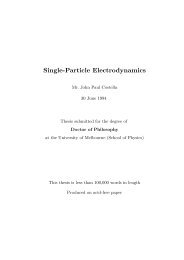HERF Data #3 - Assassination Science
HERF Data #3 - Assassination Science
HERF Data #3 - Assassination Science
Create successful ePaper yourself
Turn your PDF publications into a flip-book with our unique Google optimized e-Paper software.
Note that, strictly speaking, this fault analysis is valid for a particular aircraft on a particular<br />
flight path in a particular location at a particular time of day and year. There are implicit<br />
correlations between some of the components which means that truly independent probabilities<br />
do not exist for the components. For example, the probability of avionics susceptibility depends<br />
on the frequency of the emitter but this depends on which emitter is being considered, which, in<br />
turn, depends on the flight path. For this reason, a more legitimate approach is to calculate the<br />
entire probability chain for an actual flight with an actual set of emitters. If a representative set<br />
of flights is available, the overall probability can be obtained by taking the average over the set of<br />
flights.<br />
Each of the components will be discussed in turn and estimates presented for the associated<br />
probabilities. Table 1 summarizes the information on each of these components. The two<br />
features unique to this risk study are (1) the use of actual flight path positions as obtained from<br />
radar recordings in the Denver and Seattle areas and (2) the use of information on all the relevant<br />
emitters in the Denver and Seattle areas. Because of their importance, specific flight paths,<br />
specific emitters, and their correlation will be dealt with more fully in a later section.<br />
TABLE 1. FAULT COMPONENT SUMMARY<br />
Fault Component Component Probability Value Component Value Sources<br />
P(flight) Varied, refer to:<br />
• Government databases for emitters<br />
- Section on “Aircraft, Emitters,<br />
and Correlations”<br />
• FAA recordings of aircraft<br />
positions during flight<br />
- Table 11<br />
• Electromagnetic levels from<br />
standards groups<br />
• EMA analysis<br />
P(active) 1 • Estimate from industry experience<br />
P(orient) 1<br />
(2π / dΩ)<br />
• Assumed worst case<br />
• Unless known to operate with<br />
single-fixed antenna beam and<br />
direction<br />
P(avionics) 1 • Assumed worst case<br />
• May be adjusted for a fleet with<br />
known aircraft composition<br />
P(frequency) • Refer to table 3 • Estimate from industry experience<br />
P(level) • Refer to figures 2 and 3 • Estimate from industry experience<br />
P(catastrophic) 0.1 • Estimate from industry experience<br />
P(flight).<br />
This is the probability that, during flight, an aircraft is exposed to HIRF at or above some<br />
specified level. As stated above, this depends on flight path and emitter information which will<br />
be detailed in Aircraft, Emitters, and Correlations.<br />
3








